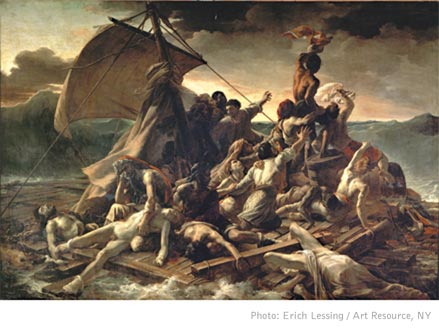


by Kathleen Cason
Intro
| Revolution and Abolition
| Widening the Canon
| Found in Translation


Doris Kadish, professor of French and women’s studies and interim director of UGA’s Institute of Woman’s Studies, analyzes works by little-known 19th-century women to understand attitudes about race and slavery.
Revolution and Abolition
Through years of studying and teaching French literature, Kadish became drawn to works by women, like Claire de Duras, who wrote in the late 18th and early 19th centuries. This period in French history was marked by political upheaval — the beheadings of Louis XVI and Marie Antoinette, the rise and fall of Napoleon, and the subsequent restoration of the monarchy. The period also was marked by social upheaval, when the ideals of “Liberté, Egalité, Fraternité” clashed with the savage treatment of slaves in France’s Caribbean colonies.
Novels such as Ourika provided insight into the social attitudes and political alliances of the time, Kadish said. Moreover, Duras’ book described, for the first time in the French language, the effects of colonialism, racism and slavery from a black person’s perspective.
“Ourika was a radical work that uncovered the foundations of the racist prejudices of the aristocracy,” wrote Françoise Massardier-Kenney, a professor of French at Kent State University, in the book Translating Slavery: Gender and Race in French Women’s Writing, 1783-1823, which she co-edited with Kadish.
The story of slavery in the French colonies is vastly different from the one people know in the United States, Kadish said. “Americans see slavery as our thing, but it wasn’t just our thing.” Only six percent of the slaves taken from Africa landed in the United States; two-fifths ended up in the French colonies of Guadeloupe, Martinique and Saint Domingue (Haiti), largely to provide labor for sugar plantations.

Viewed as a scathing criticism of the government that appointed an incompetent as captain of the frigate Medusa, this painting scandalized society and contributed to renewed interest in abolitionism. The ship went aground off the West African coast in 1816. With insufficient lifeboats, the captain saved himself and privileged passengers but left some 150 men adrift on a hastily constructed raft. Only 15 of those men survived the ordeal. The Raft of the Medusa by Théodore Géricault (1791-1824). 1819. Oil on canvas. Louvre, Paris, France.
“Slavery was particularly brutal in the French colonies,” she said. “Sugar is a horrible, punishing product to grow. The plants are huge and they’re rat-infested and it’s grueling work.”
But sugar made France rich.
Sugar production on Guadeloupe was so valuable that France relinquished all of New France (Canada) at the 1763 Treaty of Paris in exchange for keeping ownership of that single island. By the year of the French Revolution, “Saint-Domingue was arguably the most profitable colony of the Western world, with world production records for both sugar and coffee,” wrote anthropologist Michel-Rolph Trouillot in the NACLA Report on the Americas (Jan/Feb 1994). “It was also the worst place in the world to be black.”
Reports of inhumane conditions and cruelties under slavery kindled the abolitionist ideas that flourished in French literature at the end of the 18th century. “Leading up to the French Revolution of 1789, talk of freedom was widespread,” Kadish said. “Abolitionism flourished for a while, with well-intentioned people promoting every kind of freedom.” These ideas caught fire in the colonies, where slaves tried to seize freedom for themselves. During the ups and downs of French politics over the next few decades — slaves revolted in the colonies, the French Assembly outlawed slavery, then Napoleon restored it, and finally Haiti gained independence — abolitionist sentiments were censored.
When Napoleon’s government was replaced by a new monarchy, former planters and colonists viewed the change in power as another opportunity to reinvade Haiti and reclaim their property. “That brought the abolitionists back to the surface,” Kadish said.
Other events contributed to renewed efforts to free slaves. The 1815 Congress of Vienna condemned slavery, although with little immediate effect. A year later, when the French frigate Medusa ran aground off the West African coast en route to Senegal, the captain saved himself and privileged passengers but left 150 people, most of whom were soldiers, adrift on a hastily constructed raft. The incident outraged French society, especially when the Paris Salon of 1819 featured Géricault’s 16-by-23-foot painting The Raft of the Medusa, which portrayed the tragic shipwreck.
“Starting in the early 1820s, a flood of literature — poems, plays, novels, essays, newspaper writings — just hundreds of pieces were written about blacks,” Kadish said. “Some are well-known, such as Bug Jargal by Victor Hugo.”
This new wave of French abolitionist literature included many works by women. Unlike American and English women, Kadish said, French women enjoyed influence in the public sphere — but only regarding certain topics. “Anything that had to do with women, children and the plight of the poor and the needy was an appropriate subject for women.” Abolition was considered to be such a subject.
Intro
| Revolution and Abolition
| Widening the Canon
| Found in Translation
For comments or for information please e-mail the editor: jbp@ovpr.uga.edu
To contact the webmaster please email: ovprweb@uga.edu
![]()